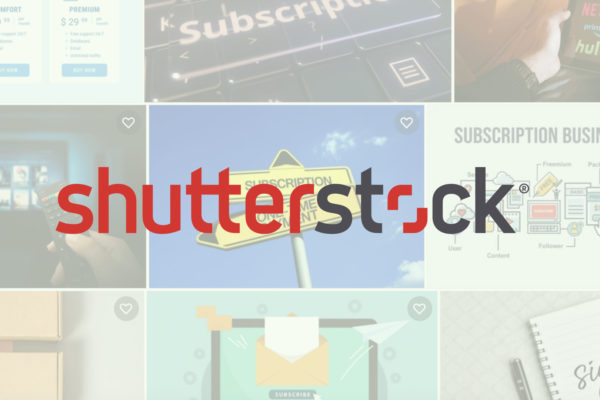Shutterstock on building – and evolving – a successful media subscriptions business
At the FIPP D2C Summit last month, FIPP President & CEO James Hewes sat down with Shutterstock, to find out how the now 18 year old business has evolved over time. Joined by Candice Murray, VP of Editorial, and Ben Giles, Director of Media for the UK and DACH, we were given exclusive insights into the company’s successful application of data, pricing, onboarding and more.
Founded in 2003 and now traded on the New York Stock Exchange (NYSE), Shutterstock is one of the original digital media subscription success stories. With revenues of US $667m in 2020 and 700 employees around the world, as well as an extended network of content contributors, the stock image, video, music, and wider content company earlier this year rolled out its Newsroom product, for 24/7 access to breaking news and content in real-time.
In opening the interview, Murray broke down the company’s development over the last two decades:
“Shutterstock has evolved quite a bit over the last 18 years. We started very much as a frictionless, two-sided marketplace where contributors could upload content and buyers – or licensees – could come and license content. And also that was very much focussed on creative imagery to start with. But, the core of that offering included a subscription that the customers would come and acquire from Shutterstock.”
“Fast forward 18 years, and in addition to building out the licenses we offer to our customers and the creation of an enterprise sales organisation, we’ve launched a number of different product offerings from creative footage to editorial, and a highend photo collection named Offest. We acquired PremiumBeat, which is our music collection, and have continued to build, getting into custom production through our Shutterstock Studios brand.”
Of course, all of these products are not dreamed up out of thin air. As Murray explains, the key to expanding the product portfolio in a successful way over the years has been to put the customer needs first and develop dedicated solutions from there.
“We’ve become a pretty comprehensive ‘one stop shop’ for our customers. At the core of that is focussing on what our customers need and packaging up all of our products and services to meet those needs. It’s about starting with the customer use case and focussing on what problem businesses are trying to solve. And then looking at your different types of customers and the volume of content that they may need to solve that problem. It’s important to use your own data from years gone by to develop the right products for them and hopefully hit that sweet spot from a pricing standpoint too.”
For Ben Giles, Director of Media for the UK and the DACH region, data is key to developing successful subscriptions offerings.
“Yeah I mean we use a ton of data to inform ourselves on all of our customers. And I think just looking at the data from Q1, we saw subscribers increase by 46% to 306,000, subscriber revenue increased by 20% to $76.5m, and the average revenue per customer increased by 4% to $342. So those are really impressive numbers and really drilled from the data that we receive.”
“But it’s also really interesting looking at the data to see the new types of customers, especially over the last few months. We’ve seen a lot of small business that have had to build a digital presence in the pandemic. We’ve seen prosumers looking for content for social channels and websites. And then enterprise customers have been leveraging us for global distributed production capabilities, which actually began during the travel limitations, but have stayed on due to the high quality and efficiency in costs.”
He also highlights the importance of arriving at the right price point, within the context of the content volumes that you’re doing for different types of content. This was understandably a big theme at the D2C in general, because different businesses are offering different things, and as subscription platform Zephr recently broke down in a newly published report, there are many different ways to bundle content.
“Price is obviously really important for us, and it’s really important that we have the right price point for conversion. For us, price is tied to volume and again during the pandemic there was a whole new set of needs from different customers – be it websites, social, plus all these new smaller clients that needed a smaller amount of volume. Then it’s important to look at the formats that the different clients were looking at. So price is really important within all of that in terms of the volume and then the assets that they’re using.”
In terms of onboarding, Murray says that the company is in a unique position because they have very specific content that multiple different types of customer are looking for. Additionally, a creative approach to partnership building has also allowed Shutterstock to get in front of more users-turned-subscribers as well.
“Well look I mean paid media will only take you so far,” says Murray. So we use that ‘D’ word again – our own first-party data to make sure we’re targeting the right customers and capitalising on a customer profile that we’ve seen to be successful.”
“But we’ve also shifted in taking on a platform approach, in addition to kindof directly marketing our product. We currently have over 8,000 API integrations including native integrations with Facebook, Microsoft, HubSpot, Wix, and a number of others. This enables a customer to actually subscribe and use Shutterstock content through where they’re actually conducting their own business. That has been wildly successful, and they end up using us much more through these platforms.”
“I would say we’re in a really great position because we have content. That’s what they’re licensing – or acquiring – from us. Therefore, we always go in with a content led strategy and then we package and put relevant content in front of our customers that again helps them to solve their problems. That is key to retention. So yes onboarding and the platform and the merchandising of our content is really important as a process, but I think staying relevant and constantly packaging valuable content is the real key to retention for us.”

Finally, having covered the launch of Shutterstock Newsroom earlier this year, we asked Murray about some of the specific thinking that led to that launch and how it had gone over the first few months.
“What we realised – and I guess it did start pre-pandemic, but certainly heightened during – is that our customers, who we believe are our partners in terms of their newsrooms and their teams of editors, were being asked to publish a heck of a lot more content with fewer and fewer resources, it seemed every single day.”
“So as leader of our editorial business and thinking ok well we have a feed of 20,000 photos and video clips that are coming into our editorial collection every day, how do we effectively leverage that for them? We already have teams of subject matter experts, plus 1,000+ active photographers and videographers around the world… how do we activate these teams to curate and get relevant content in front of our customers in a way that is almost pre-packaged to a point, that they can wrap their story around?”
“We did that and volume of use started to increase day by day. We accelerated the launch of Newsroom and then said wow at these types of volumes knowing subscriptions were so successful across other parts of our business, how do we partner with our customers in this space customers in this space to create an even more convenient way for them to get this ongoing content…”
“We are literally in the midst of launching this newsroom subscription and we’re really excited about it and think that it will be successful. Not that breaking news wasn’t important in the past, but my goodness with where the world is today, breaking news is more and more important – everybody wants to publish it first, and that’s what triggered us to activate this team of experts.”









